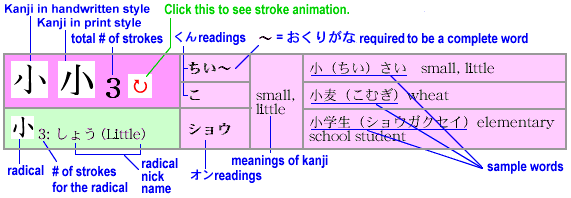Explanation
of Kanji Entry Format
 |
| ● |
When you write kanji, try to copy the handwritten style (on the left). Do not copy the kanji in print style. |
| ● |
くん reading = pronunciation native to Japan. Written in ひらがな. (The reading introduced in the lesson is written in a larger font.) |
| ● |
オン reading = pronunciation originated in China. Written in カタカナ. (The reading introduced in the lesson is written in a larger font.) |
| ● |
The "~" symbol (pronounced as なになに "so-and-so")
in the くん readings means that a particular kanji requires
additional ひらがな (called おくりがな) to be a complete word
as in
|
| ● |
A "radical" is a component of kanji that is used to classify each kanji systematically. You will also see this information in a kanji dictionary. The nickname of the radical is written on the right. |
| ● |
Some kanji compounds are, by convention, read in certain ways as
a whole, and cannot be subdivided into the オン vs. くん reading for each
character. For example, the word 今日 is pronounced as きょう ("today")
as a whole and it cannot be subdivided into separate kanji readings
for 今 and 日. Such words are noted with a red flag ( |